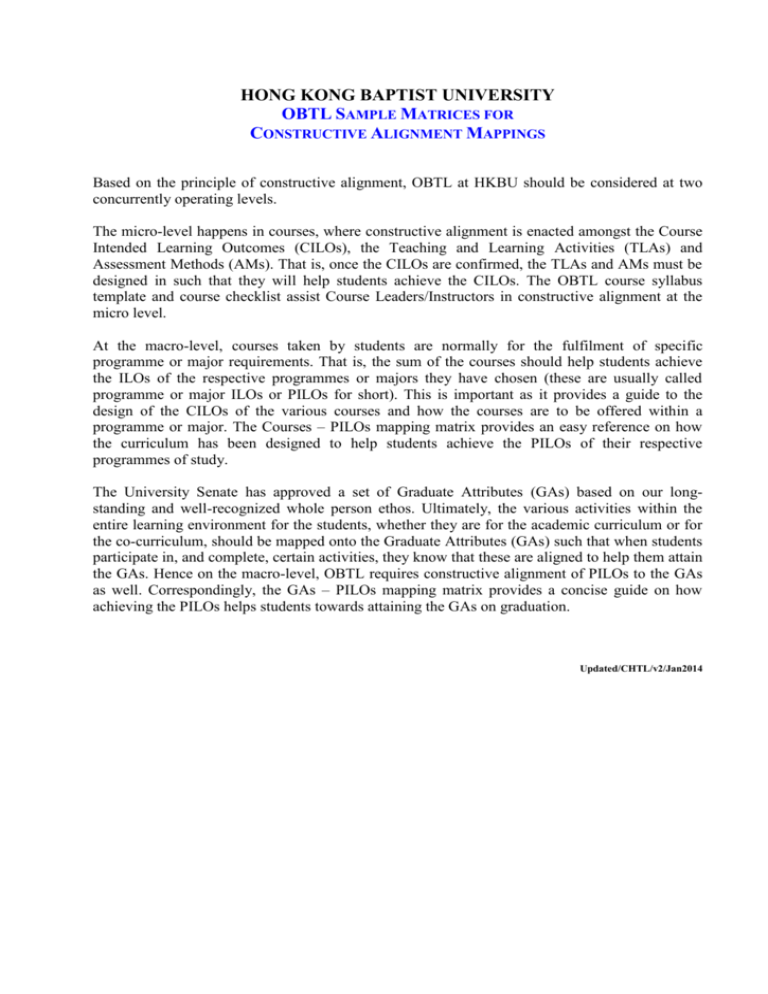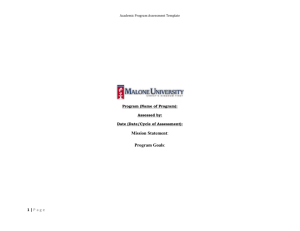Recommended ILOs Mapping Matrices
advertisement

HONG KONG BAPTIST UNIVERSITY OBTL SAMPLE MATRICES FOR CONSTRUCTIVE ALIGNMENT MAPPINGS Based on the principle of constructive alignment, OBTL at HKBU should be considered at two concurrently operating levels. The micro-level happens in courses, where constructive alignment is enacted amongst the Course Intended Learning Outcomes (CILOs), the Teaching and Learning Activities (TLAs) and Assessment Methods (AMs). That is, once the CILOs are confirmed, the TLAs and AMs must be designed in such that they will help students achieve the CILOs. The OBTL course syllabus template and course checklist assist Course Leaders/Instructors in constructive alignment at the micro level. At the macro-level, courses taken by students are normally for the fulfilment of specific programme or major requirements. That is, the sum of the courses should help students achieve the ILOs of the respective programmes or majors they have chosen (these are usually called programme or major ILOs or PILOs for short). This is important as it provides a guide to the design of the CILOs of the various courses and how the courses are to be offered within a programme or major. The Courses – PILOs mapping matrix provides an easy reference on how the curriculum has been designed to help students achieve the PILOs of their respective programmes of study. The University Senate has approved a set of Graduate Attributes (GAs) based on our longstanding and well-recognized whole person ethos. Ultimately, the various activities within the entire learning environment for the students, whether they are for the academic curriculum or for the co-curriculum, should be mapped onto the Graduate Attributes (GAs) such that when students participate in, and complete, certain activities, they know that these are aligned to help them attain the GAs. Hence on the macro-level, OBTL requires constructive alignment of PILOs to the GAs as well. Correspondingly, the GAs – PILOs mapping matrix provides a concise guide on how achieving the PILOs helps students towards attaining the GAs on graduation. Updated/CHTL/v2/Jan2014 The following matrix in Table 1 is a sample of how the mapping of courses to the PILOs can be shown such that both teachers and students can be made aware of the coverage of the PILOs as well as the rationale for the offering of the various courses. Table 1. The OBTL PILOs – Courses Mapping Matrix Courses \ PILOs Course 1 Course 2 Course 3 Course 4 … PILO1 Exchange Internship X X PILO2 PILO3 X … PILO4 X X X X X X X X X X X As for the constructive alignment of PILOs to the Graduate Attributes, the mapping in Table 2 is a sample and example of how the PILOs of a programme are mapped to the HKBU Graduate Attributes (GAs). This will further assist both teachers and students identify how successful completion of the PILOs can help the students to attain the Graduate Attributes. Table 2. The OBTL GAs – PILOs Mapping Matrix No. of GAs addressed Citizenship Knowledge Learning Skills Creativity Communication Teamwork by this PILO HKBU Graduate Attributes1 PILOs PILO 1 X X PILO 2 X X PILO 3 X PILO 4 … X X 3 X 2 X X No. of PILOs 2 addressing this GA X X X 3 2 3 3 3 2 3 3 4 Both Tables 1 & 2 and descriptions on their contents are required OBTL components in an OBTL Programme template. Related resources and links, such as the OBTL programme checklist, OBTL course syllabus checklist, the OBTL course syllabus template and regulations from AR can be found at URL – http://www.hkbu.edu.hk/chtl/main/prog-accreditation/






